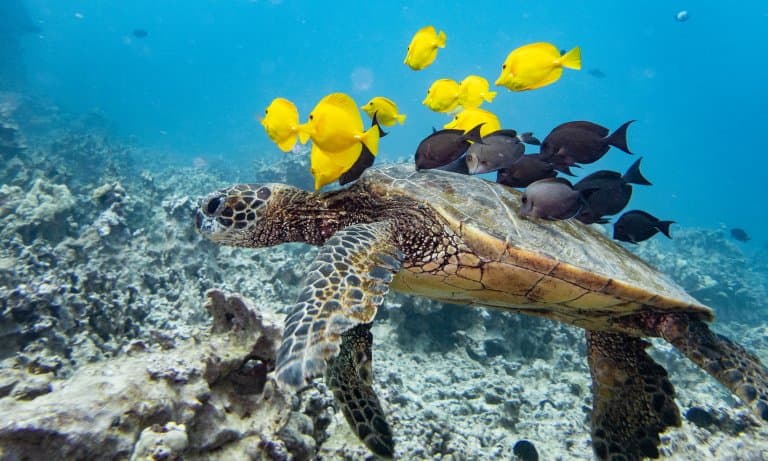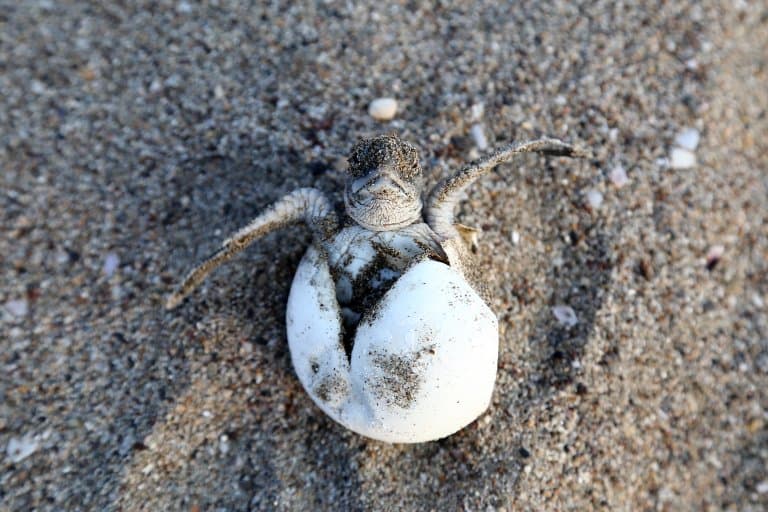Green Sea Turtle Profile
There was going to be a joke here about an ancient race of aliens called the Chelonians, but after a bit of research, it appears Dr Who got there first. Chelonia was the old word for the order of the tortoises and turtles, now known as Testudines.
Now, it’s more commonly used to describe a particular genus of turtles, the ancient and enigmatic green sea turtles.
The green sea turtle is a large species of sea turtle, found in warm coastal marine waters in two distinct populations in the Atlantic and Pacific Oceans, as well as the Indian Ocean.

Green Sea Turtle Facts Overview
| Habitat: | Warm coastal marine waters |
| Location: | Worldwide, across 140 coasts, nesting in 80 countries |
| Lifespan: | 70 – 80 years |
| Size: | 1.2m (4ft) long |
| Weight: | 160kg (350lb) |
| Colour: | Yellow-green with cream colours |
| Diet: | Sea grasses and algae, some crustaceans |
| Predators: | As juveniles, everything. As adults, only large sharks. |
| Top Speed: | 12.6km/h (7.8mph) in bursts |
| No. of Species: | 1 |
| Conservation Status: | Endangered |
Green sea turtles are also known as the black sea turtle, or Pacific green turtle, and they are one of the best candidates for a spirit animal.
They’re generally slow-moving, they eat grass and algae, and they spend time chilling in some of the most stunning and biodiverse areas of the planet.
But they’re also long-distance athletes and survivors to the core. Theirs is a hard journey and those who make it deserve all the respect that they can get.
They certainly deserve better than drowning in our discarded fishing nets.
Interesting Green Sea Turtle Facts
1. They get their name from the fat beneath its shell
Their common name refers to the fat beneath its carapace (shell) that is green in color. This body fat isn’t something you’re able to see externally, as it’s between their organs and shell.
It turns green because of the vegetation consumed in their diets.
It’s alternative common name is the ‘black sea turtle’, which refers to its carapace, which is a olive-black color.

2. They’re old
Sea turtles are long-lived animals in general, and like Morla in the Never-Ending Story, can live to crotchety grandma status and beyond.
But the oldest example in the fossil record was a 2-meter-long turtle that dates back to 120 million years.
This means they shared their watery world with Mosasaurs and Ichthyosaurs. But this fossil has all the attributes of a modern sea turtle, suggesting the lineages go back much further than this. 1
3. They take on epic migrations
The life cycle of sea turtles has captivated tourists and researchers alike. It begins as an egg laid into a hole in the sand on a distant beach. Hatchlings waddle their way through a gauntlet of predators into the frying pan of the vast ocean.
There, they mature over several decades, taking on epic migrations of up to 4,800km. Then, when it’s time to reproduce, they find their way home. 2

4. And we don’t know how
Magnetic fields cover the Earth from pole to pole, and while we’re totally oblivious to them, many animals aren’t. We know that many migratory animals rely on these fields to navigate, using them as map lines to follow as they travel from one place on the planet to another, distant, one.
Birds, bees, whales and sharks are thought to be among them, and we know this because if you strap a powerful magnet to one of them, they get entirely lost when there are no other visible cues to follow.
But when this was tried on Green Sea Turtles, the “magnetically disturbed” animals still completed their long-distance task, meaning there’s a deeper mystery around how they manage to find their way home. 3
5. Up to 64,000 green sea turtles gather together at nesting sites
Researchers used drones to help calculate the large green sea turtle population on Ranie Island in the Great Barrier reef.
The Raine Island Recovery Project estimated there were 64,000 endangered green turtles at the rookery, which was almost twice as many as previously believed.
6. They’re sometimes plankton
For a while, at least. When the youngers first plop into the ocean from the beach, it’s thought they’re entirely at the mercy of the currents.
While they can flap their little paddle arms around cutely, this takes a lot of energy, and it’s hypothesised that it’s far more effective in the early stages to let go and follow the ocean currents.
As they get bigger and stronger, they start to employ more choice in where they’re going but for a while in the early days, they’re unpowered. 4 5
7. They can slurp up jellyfish like spaghetti
Unlike hawksbill sea turtles, green sea turtles are mostly herbivorous and will typically diet on vegetation, sea grasses and algae as adults.
However, they can eat hydrozoans, jellyfish and sponges, many of which are venonmous and toxic to humans and other animals.
They will close their eyes, and use their flippers with tough skin as a shield from the stringing tentacles.
Their sharp beak will enable them to attack venonmous jellies, hydrozoan and the Portuguese man o’ war – and slurp them up like spaghetti.
8. They can sleep underwater for hours
Green sea turtles spend most of their lives submerged in water, but must breath air to survive. This means every 4-5 mins, they will appear the surface to take in oxygen.
The sea turtles blood can deliver oxygen efficiently around the body that it’s able to sleep underwater for a few hours at a time, without the need for air.
9. They are survivors
An adult green sea turtle is a testament to survival. Living to around 70 or more years, an adult green sea turtle may be the only one of 10,000 babies to have survived to maturity.
Maturity can take anywhere between 20 and 40 years to reach, and in this time, they’re food for almost everything in the ocean.
As adults, their only predators are the larger, less fussy sharks like tiger sharks and bull sharks, but until then, birds, various bony fishes, crabs, squid and all of the smaller sharks are likely to take a bite out of a baby turtle, and that’s if they make it to the land.
On hatching, they also have dogs, crabs, racoons, cats, lizards, foxes, and everything else to deal with.

10. They’re evasive
Mature Loggerhead Sea turtles appear to be killed by sharks five times as much as Greens, and this is something that has caught the attention of researchers.
Greens have burst speed at their advantage. They’ve been recorded hitting short bursts of around 3.5m/s (12.6km/h), which the wider internet seems to have mistakenly converted directly into 35km/h, and even in some places, an incredible 35mph – more than four times their recorded speed.
Loggerheads are slower, but neither species is anywhere near as fast as a tiger shark, so there must be more to it than pure speed.
Green sea turtles spend a lot less time at the surface to breathe, and quickly retreat to the relative safety of the ocean floor, unlike Loggerheads who dwell sometimes for several minutes with their heads out of the water.
Loggerheads have been seen turning their shells toward an attacking shark to prevent the predator from getting a good bite, much in the way a flat hand avoids a horse’s teeth when feeding it a carrot.
While this doesn’t appear to have been caught on camera in Greens, it is well documented as a defence strategy in this species too. 6 7
11. We’re driving them to extinction
Sea turtles are getting the worst of human ecological impacts from every angle. From tourists stealing their eggs to polluted beaches and waters, invasive species like cats and dogs, and ocean acidification affecting their food supply, the turtles are in serious trouble.
But one of the most appalling modes of destruction for turtle species across the board is a ghost net. Bycatch is always going to be a problem with the catastrophic industrial fishing methods, but even worse is the practice of discarding unusable nets into the ocean where they can remain lethal to wildlife for hundreds of years.
Floating around in ocean currents, these plastic traps ensnare countless billions of individuals of all species, and when turtles get stuck, they slowly drown there. The global demand for seafood is a lesser-known evil and one that continues to devastate our marine wildlife. 8

Green Sea Turtle Fact-File Summary
Scientific Classification
| Kingdom: | Animalia |
| Phylum: | Chordata |
| Class: | Reptilia |
| Order: | Testudines |
| Family: | Cheloniidae |
| Genus: | Chelonia |
| Species: | Chelonia Mydas |
Fact Sources & References
- (2015), “Oldest fossil sea turtle discovered: Huge fossilized turtle is at least 120 million years old”, Science Daily.
- F.V. Paladino (2001), “Sea Turtles”, Science Direct.
- F. Papi (2000), “Open-Sea Migration of Magnetically Disturbed Sea Turtles”, The Company of Biologists.
- “SEA TURTLE LIFE CYCLE – Juveniles”, NSU Florida.
- Ross Witham (1991), “ON THE ECOLOGY OF YOUNG SEA TURTLES”, JSTOR.
- Philippine Chambault (2015), “Dispersal and Diving Adjustments of the Green Turtle Chelonia mydas in Response to Dynamic Environmental Conditions during Post-Nesting Migration”, Journals Plos.
- Storyful Viral (2023), “Turtle Fights Off Shark After Ocean Battle”, YouTube.
- National Geographic, “Turtle Evades a Shark Attack”, YouTube.
